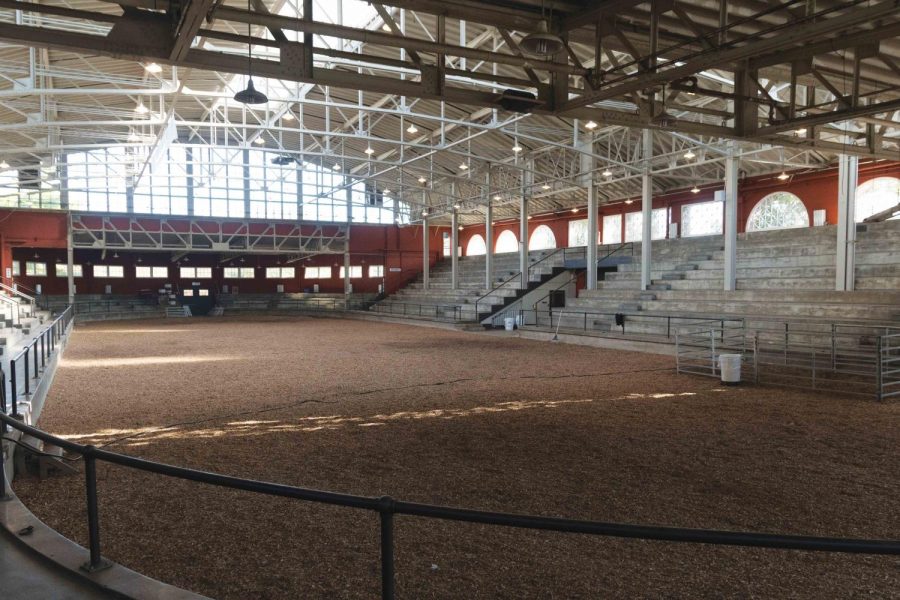Uncovering Stock Pavilion’s rich history
The Stock Pavilion is used for many things, like flying drones, testing engineering experiments, or for hosting class.
Oct 16, 2017
There are many buildings on the University’s campus, but most of them are not as versatile as the Stock Judging Pavilion on the South Quad.
The Stock Pavilion, constructed in 1912, was originally made as a place for judging and studying stock. It was even equipped with a slaughter room, which today sits adjacent to a modern classroom. The Stock Pavilion is still overseen by the Department of Animal Sciences, which holds classes in the building.
Dr. Doug Parrett is a lifelong native of Illinois and the interim head of the Department of Animal Sciences. He has retired and returned twice to the department.
“The Stock Pavilion’s primary use is for labs, where we bring animals in from our farms … so we can give students hands on experience,” Parrett said.
A few days prior in one of those labs, students gathered around a steer with a hole in its stomach — a cannula. Through this hole, students observed the animal’s digestive processes to determine the best methods of feeding.
Get The Daily Illini in your inbox!
The instructional use of the building isn’t restricted to animal science; engineers conduct experiments in the building as well.
“(There is) a lot of technology with drones (and other) technologies,” Parrett said. “Architecture often comes in here to build paper-mache skyscrapers.”
He said students also work with robot technology in the space.
The big open space has served many purposes and inspired many visions for the building. In the past, it has served as a fire station and a south campus union.
Even with the building’s versatility, animal sciences are the primary user of the building, since it is basic to their core function, Parrett said.
Parrett said this does not restrict the use of the building.
“It is used by a wide range of student clubs,” Parrett said. “There are students who come in here and dress up as medieval knights, and they’ll have practice battles and talk about strategy … There are theatre students who will perform Shakespearean plays to small crowds of 40 to 60.”
Parrett also said that the Krannert Art Museum has set up a rainforest display in the past, and the Horticulture Club holds its annual Mom’s Weekend flower show.
The YMCA also hosts its annual “dump-and-run” sale inside the auditorium. Dan Shike, assistant professor in animal sciences, testified to the grandeur of this second-hand sale.
“This whole place, every step, will be full of stuff, and the whole arena floor,” Shike said. “It’s a gigantic garage sale.”
Parrett has had a career that took him all over the world. He has traveled to New Zealand, Australia, Canada and across the states to judge and grade livestock.
Hidden in the bowels of the Stock Pavilion is an old taxidermy steer — a castrated bull. This steer, named Broadus White Sox, was judged the grand champion of the 1922 Chicago international livestock pavilion at the union stockyards.
Broadus White Sox, like Parrett, has traveled the world, going across the Atlantic to Paris for exposition and then returning to campus. Sitting in the annals of the English Building for years, Parrett said the steer transported him all the way to the Stock Pavilion in the mid-1980s — where Broadus White Sox sits today.
Broadus White Sox isn’t the only animal sciences artifact the department head collected during his tenure.
Parrett is the historian of the Department of Animal Sciences. His office is littered with old documents, pictures and artifacts. He has an old terracotta gargoyle of a pig’s head.
These gargoyles once lined the north wall of the Stock Pavilion. Upon the building’s first renovation, these gargoyles were taken down and either destroyed or dispersed around the Champaign-Urbana area.
Parrett said he has been looking for the missing gargoyles for about a quarter of a century.
There were originally 52 of them. As of today, about a half-dozen have been found in storage rooms and have even been found in locals’ gardens.






